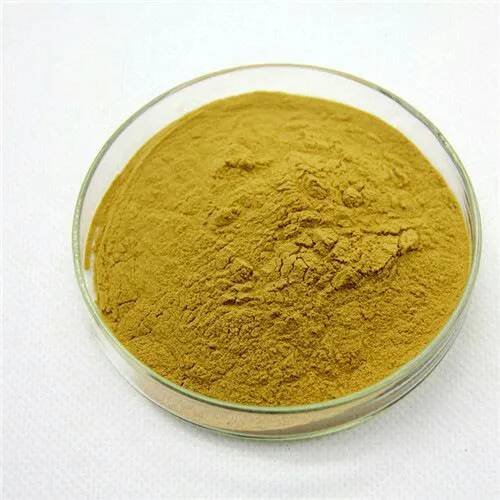- 0086-571-85302990
- sales@greenskybio.com
The best source of natural echinacea extract.
2024-11-26

Introduction
Echinacea is a well - known herb in the field of natural remedies. Its extract has been used for various health benefits, including boosting the immune system, reducing inflammation, and fighting infections. In this article, we will explore the best natural sources of Echinacea Extract, considering factors such as purity, potency, and the quality of the growing environment.

Wild - Harvested Echinacea
1. Purity and Potency
Wild - harvested echinacea is often considered a prime source of high - quality extract. One of the main reasons is its purity. When echinacea grows in the wild, it is less likely to be exposed to synthetic fertilizers, pesticides, or other chemicals that are sometimes used in commercial farming. This natural growth environment allows the plant to develop its chemical constituents in a more natural and unadulterated way, resulting in a purer extract.
In terms of potency, wild - harvested echinacea can be very powerful. The plant has to compete with other native flora for resources such as sunlight, water, and nutrients. This natural competition can stimulate the production of certain bioactive compounds in the echinacea plant. For example, the roots of wild echinacea may contain higher levels of alkamides, which are believed to be responsible for some of the herb's immune - boosting properties.
2. Sustainable Harvesting
However, it is crucial to ensure that wild - harvesting is done sustainably. Over - harvesting can lead to a decline in wild echinacea populations. Some regions have regulations in place to protect wild echinacea. For instance, harvesters may need to obtain permits and follow strict guidelines on the amount and method of harvesting. Ethical harvesters will also focus on leaving enough plants in the wild to ensure the species' continued survival and regeneration.
3. Varieties in the Wild
There are different species of echinacea that can be found in the wild. Echinacea purpurea, Echinacea angustifolia, and Echinacea pallida are some of the most common ones. Each species may have slightly different chemical profiles, which can affect the properties of the extract. For example, Echinacea angustifolia is often highly regarded for its strong immune - stimulating effects, while Echinacea purpurea may be more widely available and easier to harvest in some areas.

Organically - Grown Echinacea
1. Ideal Growing Regions
Organically - grown echinacea in specific regions known for their ideal soil and climate conditions can also be an excellent source of extract. Certain areas have soil that is rich in nutrients, such as loamy soil with a good balance of organic matter, minerals, and drainage. For example, parts of the Midwest in the United States are known for having suitable soil for echinacea growth.
The climate also plays a vital role. Echinacea generally prefers a temperate climate with distinct seasons. Adequate sunlight during the growing season, along with the right amount of rainfall or irrigation, is necessary for the healthy development of the plant. In regions like parts of Europe, where the climate is mild and well - balanced, organically - grown echinacea can thrive.
2. Quality Control in Organic Farming
Organic farming practices for echinacea involve strict quality control. Farmers are prohibited from using synthetic pesticides and fertilizers. Instead, they rely on natural methods such as crop rotation, composting, and the use of beneficial insects for pest control. This not only ensures that the echinacea is free from harmful chemical residues but also promotes a more sustainable and environmentally - friendly farming system.
Organic certification bodies regularly inspect the farms to ensure compliance with organic standards. This gives consumers confidence that the Echinacea Extract they are purchasing comes from a reliable and high - quality source. For example, the USDA Organic certification in the United States and the EU Organic certification in Europe are well - recognized standards for organic products.
3. Yield and Consistency
Organic farming of echinacea can also offer relatively consistent yields. By carefully managing the soil fertility, irrigation, and pest control, farmers can ensure that each crop of echinacea grows to a certain standard. This consistency is important for the production of Echinacea Extract, as it allows for more predictable levels of active ingredients in the final product. Additionally, modern organic farming techniques are constantly evolving to improve the yield of high - quality echinacea plants.

Advantages of Different Echinacea Species as Sources
1. Echinacea purpurea
Echinacea purpurea is one of the most popular species used for extract production. It is relatively easy to cultivate, which makes it more widely available compared to some other species. This species has a well - studied chemical composition, with components such as flavonoids, caffeic acid derivatives, and polysaccharides.
The flavonoids in Echinacea purpurea are thought to contribute to its antioxidant properties, helping to protect cells from oxidative damage. The caffeic acid derivatives may play a role in anti - inflammatory processes, while the polysaccharides are believed to be involved in immune modulation. Due to its relatively high yield and ease of growth, Echinacea purpurea extract is commonly found in many herbal products on the market.
2. Echinacea angustifolia
Echinacea angustifolia is highly regarded for its traditional use in Native American medicine. It has a long history of being used to treat various ailments, especially those related to the immune system. The roots of Echinacea angustifolia are particularly rich in alkamides, which are some of the most important bioactive compounds in echinacea.
These alkamides are thought to stimulate the immune system by activating certain immune cells. However, Echinacea angustifolia can be more difficult to cultivate compared to Echinacea purpurea. It has specific soil and climate requirements, and its growth is relatively slow. As a result, the extract from Echinacea angustifolia may be more expensive, but it is often sought after for its potentially stronger immune - enhancing effects.
3. Echinacea pallida
Echinacea pallida is another species with unique properties. It contains certain chemical constituents that may have antibacterial and antiviral activities. The plant has a slender appearance compared to other echinacea species, and its roots are also used for extract production.
Research on Echinacea pallida is ongoing, but it has shown promise in the development of natural remedies for infections. Similar to Echinacea angustifolia, it may not be as commonly cultivated as Echinacea purpurea, but it offers a valuable alternative source of echinacea extract, especially for those interested in its potential antimicrobial properties.

Conclusion
In conclusion, the best source of natural echinacea extract depends on various factors. Wild - harvested echinacea offers purity and potency, but sustainable harvesting is essential. Organically - grown echinacea in ideal regions provides a reliable and high - quality source with strict quality control. Different echinacea species also bring their own advantages to the table, whether it is the ease of cultivation of Echinacea purpurea, the strong immune - enhancing properties of Echinacea angustifolia, or the potential antimicrobial activities of Echinacea pallida. By understanding these different sources, consumers and producers of herbal products can make more informed decisions about the echinacea extract they choose to use or produce.
FAQ:
What are the main natural sources of echinacea extract?
Wild - harvested echinacea is one of the main sources, known for its purity and potency. Also, organically - grown echinacea in regions with ideal soil and climate conditions is a significant source. Different echinacea species also serve as sources for the extract.
Why is wild - harvested echinacea considered a good source?
Wild - harvested echinacea is considered good because it often has high purity and potency. It grows in its natural environment without the interference of some artificial factors, which may contribute to its high - quality extract.
What regions are known for organically - grown echinacea?
There are certain regions with ideal soil and climate conditions for growing echinacea organically. However, specific regions can vary. Some areas with fertile soil, proper sunlight, and temperature are likely to be good for its growth, but it often requires in - depth research to determine these regions precisely.
How do different echinacea species affect the quality of the extract?
Different echinacea species may have different chemical compositions. These differences in composition can lead to variations in the properties and potential benefits of the extract. For example, some species might be more potent in enhancing the immune system, while others could have different medicinal qualities.
Can the source of echinacea extract influence its effectiveness?
Yes, the source can influence its effectiveness. A pure and potent source, such as wild - harvested or organically - grown echinacea in suitable regions, is more likely to produce a high - quality extract with better effectiveness. The species of echinacea also matters as different species may have different active ingredients.
Related literature
- Echinacea: A Comprehensive Review on Its Botany, Phytochemistry, Pharmacology, and Toxicology"
- "The Role of Echinacea in Herbal Medicine: A Review of its Immunomodulatory Properties"
- "Echinacea: From Traditional Medicine to Evidence - Based Therapy"
- ▶ Hesperidin
- ▶ citrus bioflavonoids
- ▶ plant extract
- ▶ lycopene
- ▶ Diosmin
- ▶ Grape seed extract
- ▶ Sea buckthorn Juice Powder
- ▶ Beetroot powder
- ▶ Hops Extract
- ▶ Artichoke Extract
- ▶ Reishi mushroom extract
- ▶ Astaxanthin
- ▶ Green Tea Extract
- ▶ Curcumin Extract
- ▶ Horse Chestnut Extract
- ▶ Other Problems
- ▶ Boswellia Serrata Extract
- ▶ Resveratrol Extract
- ▶ Marigold Extract
- ▶ Grape Leaf Extract
- ▶ blog3
- ▶ blog4
-
Organic Tongkat Ali extract powder factory.
2024-11-26
-
How to make powder with ashwagandha extract.
2024-11-26
-
Rosehip extract manufacturers from China.
2024-11-26
-
The best cat's claw extract in nature.
2024-11-26
-
Chinese Dandelion Leaf Extract Suppliers.
2024-11-26
-
Cat Claw Extract
2024-11-26
-
Horse Chestnut Extract
2024-11-26
-
Propolis Extract Powder
2024-11-26
-
Eucommia Ulmoides Extract
2024-11-26
-
Avocado Extract Powder
2024-11-26
-
Hawthorn Extract
2024-11-26
-
Dan Shen Root Extract/Salvia Root Extract
2024-11-26
-
Tormentil Extract
2024-11-26
-
Camu Camu Extract
2024-11-26
-
Stevia Extract
2024-11-26





















